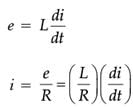Assertion & Reason Test: Alternating Current - 1 - Grade 12 MCQ
15 Questions MCQ Test - Assertion & Reason Test: Alternating Current - 1
Directions : In the following questions, A statement of Assertion (A) is followed by a statement of Reason (R). Mark the correct choice as.
Assertion (A): An alternating current does not show any magnetic effect.
Reason (R): Alternating current changes direction with time.
Directions : In the following questions, A statement of Assertion (A) is followed by a statement of Reason (R). Mark the correct choice as.
Assertion (A): VRMS value of an alternating voltage V = 4√2 sin 314t is 4 volt.
Reason (R): Peak value of the alternating voltage is 4√2 volt.
Directions : In the following questions, A statement of Assertion (A) is followed by a statement of Reason (R). Mark the correct choice as.
Assertion (A): The dimension of L/R is time.
Reason (R): Time constant (L/R) should be increased to reduce the rate of increase of current through a solenoid.
Directions : In the following questions, A statement of Assertion (A) is followed by a statement of Reason (R). Mark the correct choice as.
Assertion (A): When capacitive reactance is less than the inductive reactance in a series LCR circuit, e.m.f. leads the current.
Reason (R): The angle by which alternating voltage leads the alternating current in series RLC circuit is given by tan φ = XL - XC /R.
Directions : In the following questions, A statement of Assertion (A) is followed by a statement of Reason (R). Mark the correct choice as.
Assertion (A): Principle of operation of AC generator is electromagnetic induction.
Reason (R): Resistance offered by inductor for AC is zero.
Directions : In the following questions, A statement of Assertion (A) is followed by a statement of Reason (R). Mark the correct choice as.
Assertion (A): A transformer does not work on DC.
Reason (R): DC neither change direction nor magnitude.
Directions : In the following questions, A statement of Assertion (A) is followed by a statement of Reason (R). Mark the correct choice as.
Assertion: In series LCR circuit resonance can take place.
Reason: Resonance takes place if inductance and capacitive reactances are equal and opposite.
Directions : In the following questions, A statement of Assertion (A) is followed by a statement of Reason (R). Mark the correct choice as.
Assertion: Capacitor serves as a block for dc and offers an easy path to ac.
Reason: Capacitive reactance is inversely proportional to frequency.
Directions : In the following questions, A statement of Assertion (A) is followed by a statement of Reason (R). Mark the correct choice as.
Assertion: Chock coil is preferred over a resistor to adjust current in an ac circuit.
Reason: Power factor for inductance is zero.
Directions : In the following questions, A statement of Assertion (A) is followed by a statement of Reason (R). Mark the correct choice as.
Assertion: A bulb connected in series with a solenoid is connected to ac source. If a soft iron core is introduced in the solenoid, the bulb will glow brighter.
Reason: On introducing soft iron core in the solenoid, the inductance increases.
Directions : In the following questions, A statement of Assertion (A) is followed by a statement of Reason (R). Mark the correct choice as.
Assertion: The dc and ac both can be measured by a hot wire instrument.
Reason: The hot wire instrument is based on the principle of magnetic effect of current.
Directions : In the following questions, A statement of Assertion (A) is followed by a statement of Reason (R). Mark the correct choice as.
Assertion: Average value of ac over a complete cycle is always zero.
Reason: Average value of ac is always defined over half cycle.
Directions : In the following questions, A statement of Assertion (A) is followed by a statement of Reason (R). Mark the correct choice as.
Assertion: When ac circuit contain resistor only, its power is minimum.
Reason: Power of a circuit is independent of phase angle.
Directions : In the following questions, A statement of Assertion (A) is followed by a statement of Reason (R). Mark the correct choice as.
Assertion: A capacitor of suitable capacitance can be used in an ac circuit in place of the choke coil.
Reason: A capacitor blocks dc and allows ac only.
Directions : In the following questions, A statement of Assertion (A) is followed by a statement of Reason (R). Mark the correct choice as.
Assertion: Average power in series LCR ac circuit is maximum at resonance.
Reason: At the resonance circuit is purely resistive.





















